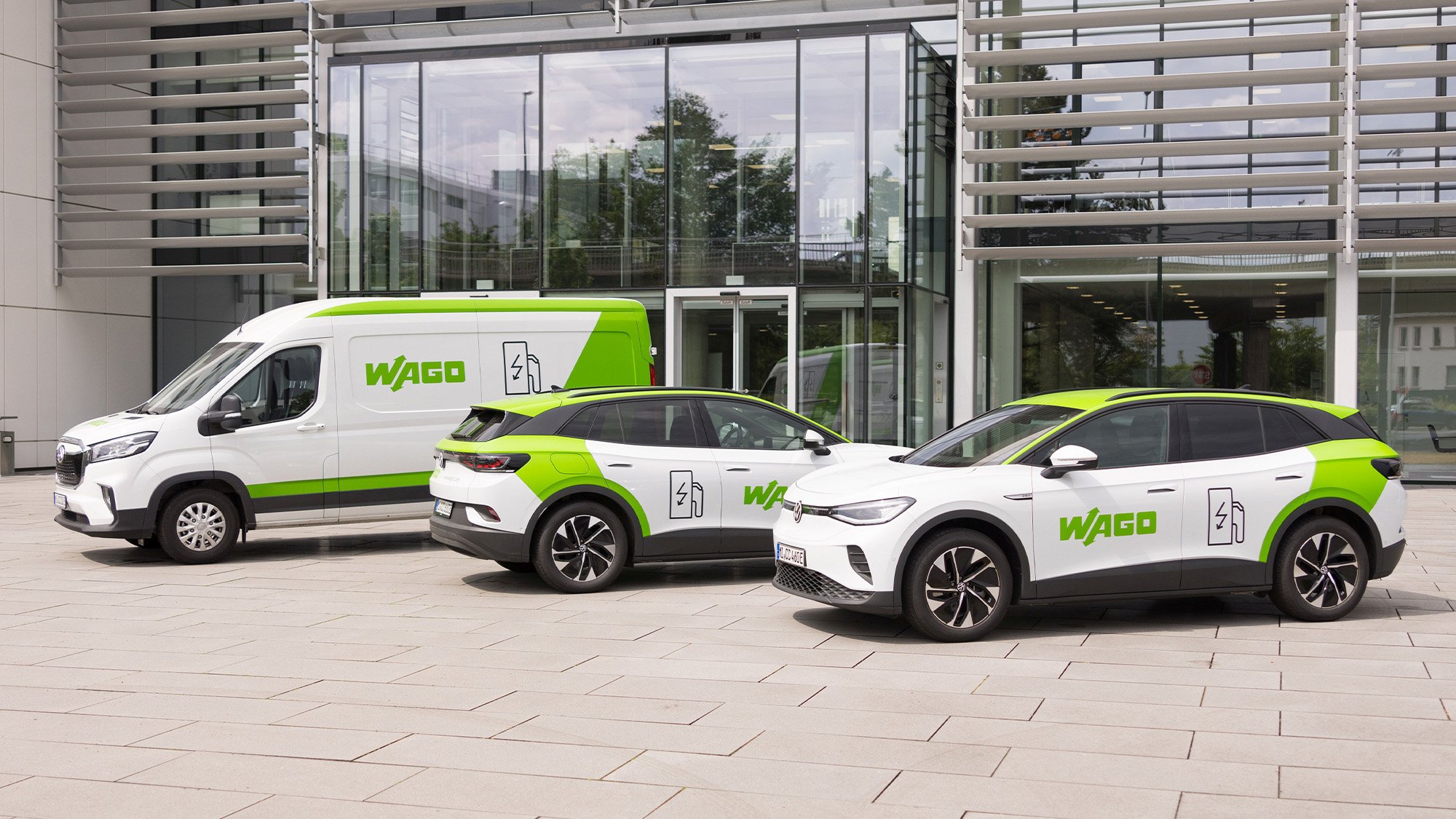The signs are pointing to electricity

WAGO company car fleet:
30 April 2024
“In 2021, we made a fundamental decision at the company,” states Dietrich Schlichter, recalling an unequivocal step. Since the introduction of the “Green Car Policy,” the fleet manager has monitored the conversion of the WAGO company fleet to e-mobility. “The project has not yet been completed,” he reports, “but it emphasizes the priority that sustainability has at WAGO.” Prior to September 2021, the vehicle fleet owned by the energy component manufacturer from East Westphalia mirrored the company car fleet of a perfectly ordinary German company. At that time, the fleet consisted of 230 vehicles – predominantly compact, diesel-powered commercial vehicles. Like all new cars, they contributed to substantial CO2 emissions. In 2021, this was still nearly 80 percent. WAGO’s decision to switch to e-mobility was, and remains, a clear commitment to climate protection. And every new e-vehicle that joins the fleet is one more step towards reducing emissions and focusing on environmentally friendly driving.
72 % Electrical
Today, around two years later, the WAGO company car fleet has grown to 270 vehicles at the three German locations. More than half – currently 145 vehicles – are e-vehicles or plug-in hybrids from various classes, sizes and manufacturers. Another 50 fossil fuel burners will be replaced by e-vehicles this year. “The speed of the fleet conversion is determined by the long delivery times for e-vehicles,” explains Schlichter, “and also by the remaining lease periods for the diesel-powered vehicles.” WAGO made a relatively early decision in favor of e-mobility. Currently, the national average of electric vehicles in company fleets has yet to top one-third. At WAGO, it's more than 72 percent. Extensive investments, not only in vehicles but also in infrastructure, created the conditions for this.
Custom Solutions
As with the design of any other charging park, the conditions on site and the individual expectations regarding the scope of services played a decisive role in the implementation. “The quality of the planning is the most important prerequisite,” says Philipp Baumann, Product Manager in the Business Unit SOLUTIONS at WAGO, as he describes the first step. Operators must clearly define their requirements, and facility managers must provide their input at this early stage. “There’s no single solution that can do everything.” Instead, WAGO develops details into the standard. This means that, “our specific tasks only arise from the customer-specific requirements for the respective charging park – from adaptation, through connection, up to programming.”
Intelligent Energy Management
The second step: Where does the energy come from? The WAGO campus has a generously designed PV system. Excess generated energy flows into the batteries of the e-fleet, among other locations. It is obvious that ensuring grid stability plays a special role, especially in conjunction with industrial production. “The charging infrastructure must run correctly and be well protected. This means that the infrastructure‘s charging capacity is dynamically determined, continuously adjusted, and optimized as a function of the total load at the location. This dynamic load management, which works to shave the peak loads, enables integrated energy management.”
The proprietary technology becomes the hardware foundation for load management in the company.
If you want to charge electric vehicles intelligently and sustainably, there is no escaping continuous power adjustment and the integration and use of all available capacities. If you want to keep a grip on electricity costs, you must absolutely avoid peak load times – which incur the highest rates. In the future, software could directly link charging times to the market prices for electricity.
“Every measure requires maximum transparency for facility management. They need to see what is happening at all times – for example, via remote access to the parameterization interface.” In practical operation, many key values are important for troubleshooting. “This topic is the focus of the cloud app,” says Baumann. Errors can quickly be detected by simply comparing the target and actual currents.
At the solution‘s core is the WAGO Load Management Controller with pre-installed WAGO Application Load Management software.
It All Began as a Trainee Project
A project run by the WAGO apprentices to enable communication with the charging infrastructure, was launched at the beginning of 2022. Florian Deerberg, who was training as a mechatronics technician at the time, was involved in developing the communication structure. “The goal was setting up a central, expandable communication structure that would enable access to a theoretically unlimited number of charging stations.” The individual application requirements stipulated functional expansions in the system, which “we provided as part of add-ons.” Florian Deerberg has now completed his training and, as a team member in Technical Services, continues developing special functional expansions for the WAGO Application Load Management. An example includes enabling facility managers to easily access an overview of the respective system. Ideas extend up to charging prioritization – for vehicles assigned to Sales or Management, for example.
Florian Deerberg, Philipp Baumann and Dietrich Schlichter have driven the load management integration at WAGO.
Brand-Open and Interoperable
“WAGO Application Load Management is consciously open-source for wallboxes from different manufacturers and is interoperable with its wide variety of interfaces. At present, we can link columns from about 30 different manufacturers into one park, says Philipp Baumann, describing the booth. Charging stations from different manufacturers are also integrated into the WAGO charging park. The 46 charging points charge at 11 and 22 kW – with more in the planning stage – and also include a hypercharger. “Basically, we can then also charge with direct current,” Baumann describes as an aspect that’s pertinent to the future.
The construction of the company’s own charging park presented many exemplary challenges for the WAGO team. Therefore, we know from our own experience where customer-relevant problems could lurk during the construction of a charging park. “Our primary concern is the simple setup and fast, uncomplicated commissioning of the WAGO Load Management. Therefore, all measures are always accompanied by the necessary support – from additional programming, if necessary, up to commissioning.
At WAGO, this also worked well for those driving the company cars. “We have overcome the ‘German anxiety’ of running out of battery charge on the way to the customer,” confirms Dietrich Schlichter with a wink. Reliable charging management can contribute to this. WAGO will set course for additional expansions of its infrastructure in the coming months.
